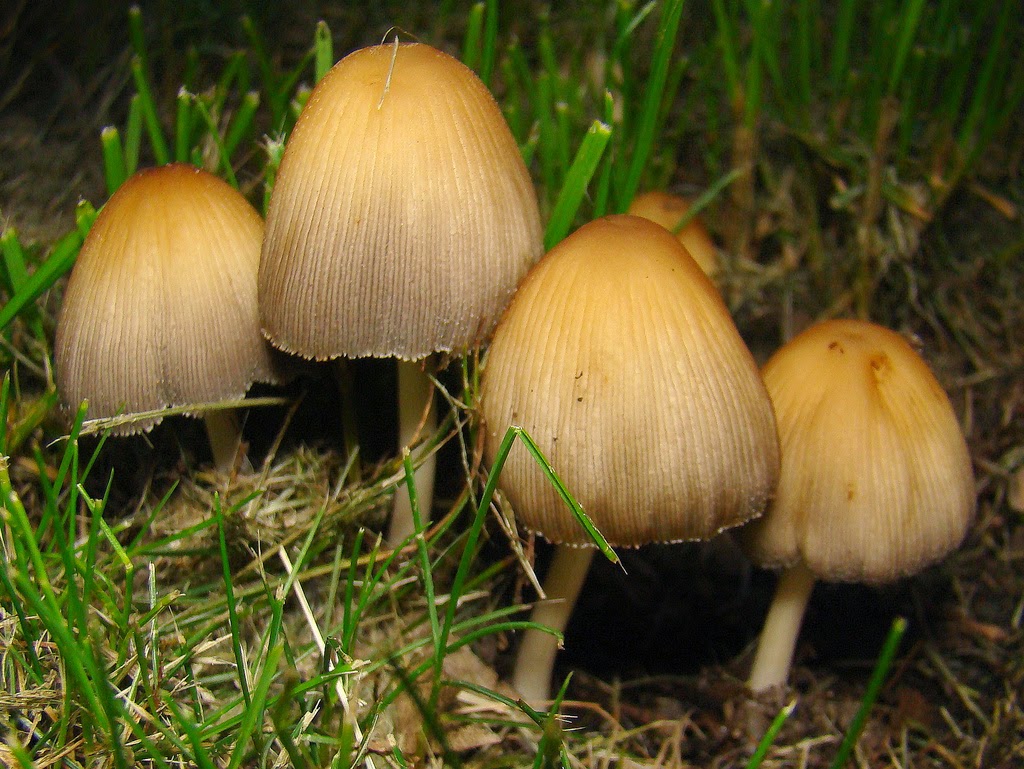The Glistening Inkcap was @SpeciesofUK from 17th
to 23rd February, 2014.
The
glistening inkcap is a fungus that is often found growing around dead wood. It
used to be known as ‘mica’ inkcap on account of the tiny granules that glisten
on the surface of immature specimens.[1]
 |
| Glistening Inkcap [Flickr Creative Commons © Donald Hobern] |
Glistening inkcap is extremely widespread. It's common in Europe and North America and also most parts of Asia, South America and Australia.[2]
Glistening inkcap is a fungus of the Psathyrellaceae family.[3]
Fungi are
a kingdom of life in their own right, just like animals and plants.[4]
Unlike plants, which have cellulose in their cell walls, and animals, which
have no cell walls, fungi have cell walls containing chitin.[5]
No one
knows how many fungi species there are. Estimates range from 1.5 to 5 million
with about 5% discovered so far.[6]
Most
fungi are tiny and inconspicuous, living underground, on dead matter, in
symbiosis with other organisms, or forming yeasts and moulds.[7]
Fungi
only become noticeable when fruiting, in particular those that form large,
fleshy, spore-bearing fruiting bodies - otherwise known as ‘mushrooms.’[8]
Glistening inkcap falls into the Psathyrellaceae family of fungi, a type of ‘dark spored agaric.’[9] It is a member of the Coprinellus genus.[10]
 |
| Glistening Inkcap [Flickr Creative Commons © anenomeprojectors] |
The taxonomic history of glistening inkcap is a
little complicated.
Originally,
in 1786, glistening inkcap was classified in the Agaricus genus along with most other gilled fungi. Agaricus has since been split out into
numerous groupings.[11]
In the
modern era glistening inkcap was placed in the Coprinus genus, alongside with another well-known fungi - the
‘shaggy inkcap.’[12]
 |
| Shaggy Inkcap [Flickr Creative Commons © Paula Bailey] |
But in 2001, the glistening inkcap was reclassified yet again based on DNA analysis and placed in a new genus called Coprinellus, where it remains today.[13]
 |
| Glistening Inkcap [Wikimedia Commons © Jean-Jacques MILAN] |
The name 'Coprinellus' refers to the fact that glistening inkcap was thought to live on dung, like the Coprinus species – confusingly, it doesn't! The 'ellus' indicates a smaller size.[14]
The
species name micaceus refers to the tiny granules (veil
fragments) that glisten like specks of mica on the surfaces of immature
glistening inkcaps.[15]
As a result, it used to be referred to as ‘mica inkcap.’
In wet
weather the mica-like granules of glistening inkcaps are washed away so that
mature caps are entirely smooth and stop glistening.[16]
Glistening inkcap grows on tree stumps or buried
wood.
Glistening
inkcap arises in clusters around tree stumps, from spring until early winter
(most of the year, really).[17]
You’re most likely to see it in spring.[18]
 |
| Glistening Inkcap Growing on Wood [Wikimedia Commons © Dan Molter] |
Glistening inkcap can appear to grow directly on the grass, but it is really growing on dead wood under the ground.
Glistening inkcap becomes bell-shaped as it
matures.
The stems
of glistening inkcap are white, but brownish at the base, and they can grow
surprisingly tall, from about 4 to 10cm.[19]
 |
| Tall Glistening Inkcap [Wikimedia Commons © H Krisp] |
As they mature, glistening inkcaps become more bell-shaped.[20]
 |
| Glistening Inkcap [Wikimedia Commons © Eric Steinert] |
The cap colour of glistening inkcap is ochre-brown or tawny with a russet central 'eye'. They darken when moist and turn grey-brown as they age.[21]
The cap
has a split or sometimes rolled-back margin that is lined and grooved almost to
the centre.[22]
The gills
of the glistening inkcap are attached, dense, white, slowly browning then
blackening with age.[23]
Glistening
inkcaps deliquesce (dissolve) after ageing, from the margin inwards.[24]
 |
| Glistening Inkcap Deliquescing [Flickr Creative Commons © Donald Hobern] |
Glistening inkcap is edible but can be poisonous if collected from polluted land/roadsides where cadmium and lead can accumulate.[25]
Glistening inkcap produces both spores and clones.
Glistening
inkcap, like most fungi, reproduces in two ways: sexually, by releasing spores;
and asexually, by cloning cells underground.[26]
The
spores are basically special cells containing one nucleus (normal fungi cells
have two nuclei), that are released from the mushroom cap.[27]
Glistening
inkcap spores are ellipsoid or shield-shaped, smooth, making dark brown or
black spore prints.[28]
When two
fungi spores combine they form a new cell with two nuclei ready to grow into a
new organism. Sexual reproduction is complete.[29]
Asexual
reproduction happens in the body of the fungus which is underground.
The cells clone, slowing spreading the hyphae of the fungus further
and further.[30]
Due to
its habit of growing on dead wood hidden from view under the ground, it’s been
said that glistening inkcap marks the graves of dead trees.[31]
[1]
http://www.first-nature.com/fungi/coprinellus-micaceus.php
[2]
http://www.first-nature.com/fungi/coprinellus-micaceus.php
[3] http://en.wikipedia.org/wiki/Psathyrellaceae
[4]
http://en.m.wikipedia.org/wiki/Kingdom_(biology)
[5]
http://en.m.wikipedia.org/wiki/Cell_wall
[6]
http://en.m.wikipedia.org/wiki/Fungus
[7]
http://en.m.wikipedia.org/wiki/Fungus
[8]
http://en.m.wikipedia.org/wiki/Fungus
[9]
http://en.wikipedia.org/wiki/Psathyrellaceae
[10]
http://en.wikipedia.org/wiki/List_of_Coprinellus_species
[11]
http://www.first-nature.com/fungi/coprinellus-micaceus.php
[12]
http://www.first-nature.com/fungi/coprinellus-micaceus.php
[13]
http://www.first-nature.com/fungi/coprinellus-micaceus.php
[14]
http://www.first-nature.com/fungi/coprinellus-micaceus.php
[15]
http://www.first-nature.com/fungi/coprinellus-micaceus.php
[16]
http://www.first-nature.com/fungi/coprinellus-micaceus.php
[17]
http://www.first-nature.com/fungi/coprinellus-micaceus.php
[18]
http://urbanmushrooms.com/index.php?id=9
[19]
http://www.first-nature.com/fungi/coprinellus-micaceus.php;
http://urbanmushrooms.com/index.php?id=9
[20]
http://www.first-nature.com/fungi/coprinellus-micaceus.php
[21]
http://www.first-nature.com/fungi/coprinellus-micaceus.php;
http://www.rogersmushrooms.com/gallery/DisplayBlock~bid~5856.asp
[22]
http://www.rogersmushrooms.com/gallery/DisplayBlock~bid~5856.asp
[23]
http://www.first-nature.com/fungi/coprinellus-micaceus.php;
http://urbanmushrooms.com/index.php?id=9
[24]
http://www.first-nature.com/fungi/coprinellus-micaceus.php
[25]
http://www.first-nature.com/fungi/coprinellus-micaceus.php
[26]
https://suite101.com/a/the-reproductive-life-cycle-of-a-mushroom-a114504
[27]
https://suite101.com/a/the-reproductive-life-cycle-of-a-mushroom-a114504
[28]
http://www.rogersmushrooms.com/gallery/DisplayBlock~bid~5856.asp;
http://www.first-nature.com/fungi/coprinellus-micaceus.php
[29]
https://suite101.com/a/the-reproductive-life-cycle-of-a-mushroom-a114504
[30]
https://suite101.com/a/the-reproductive-life-cycle-of-a-mushroom-a114504
[31]
http://urbanmushrooms.com/index.php?id=9






No comments:
Post a Comment